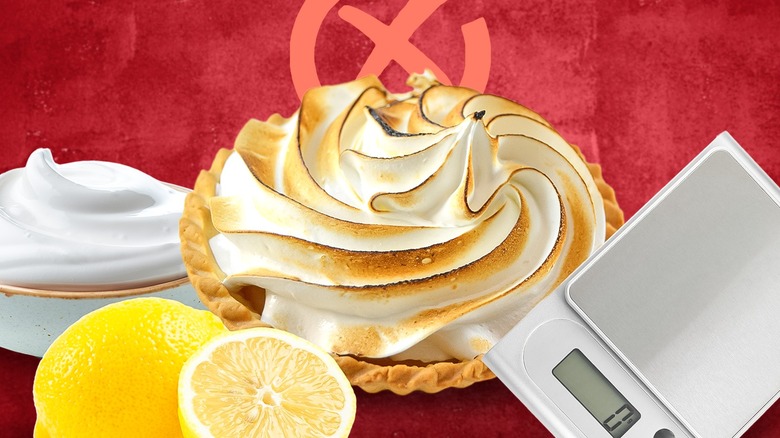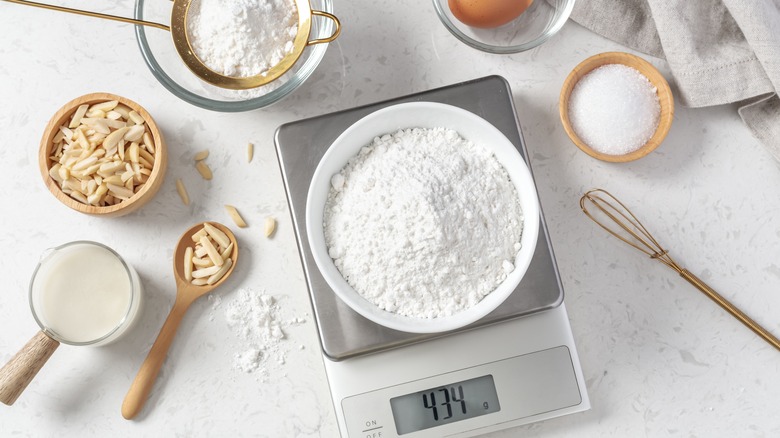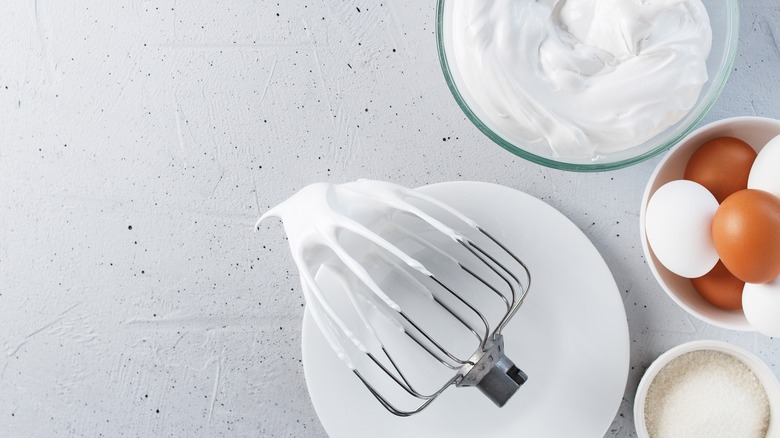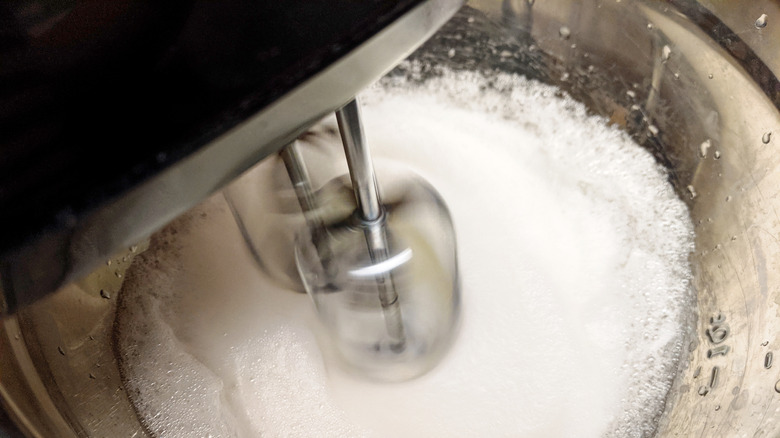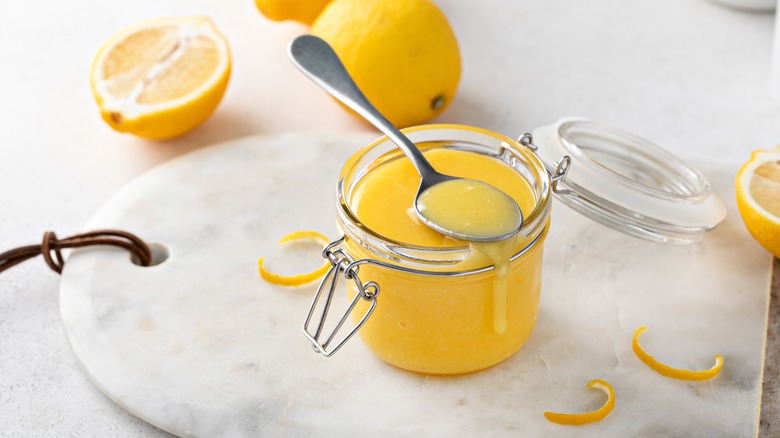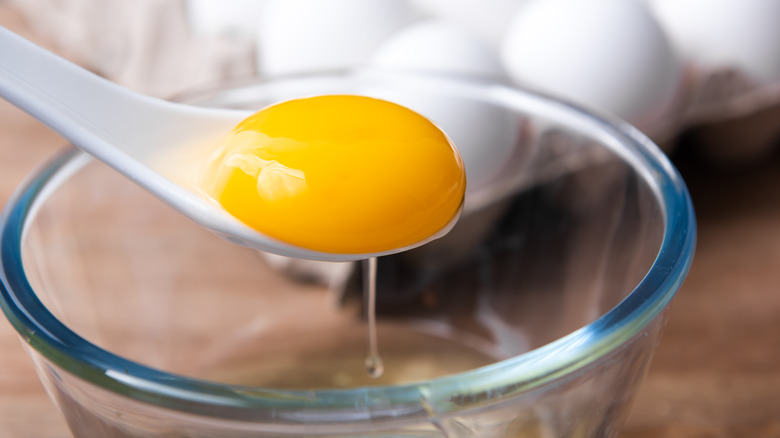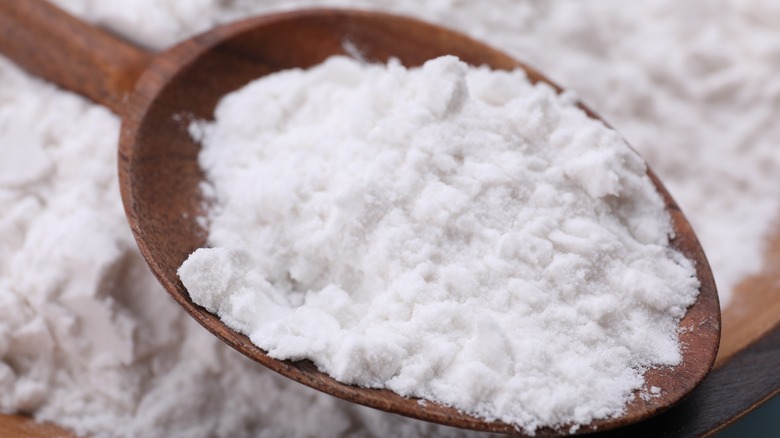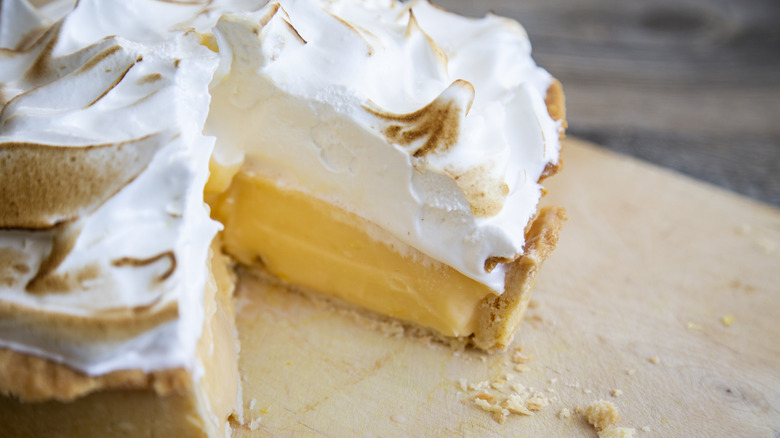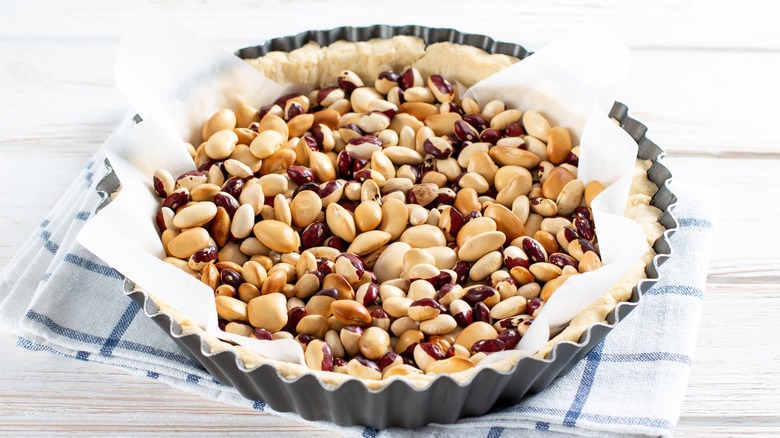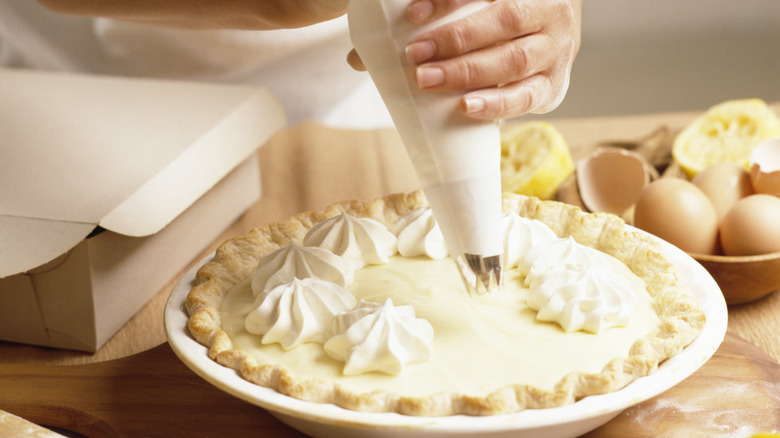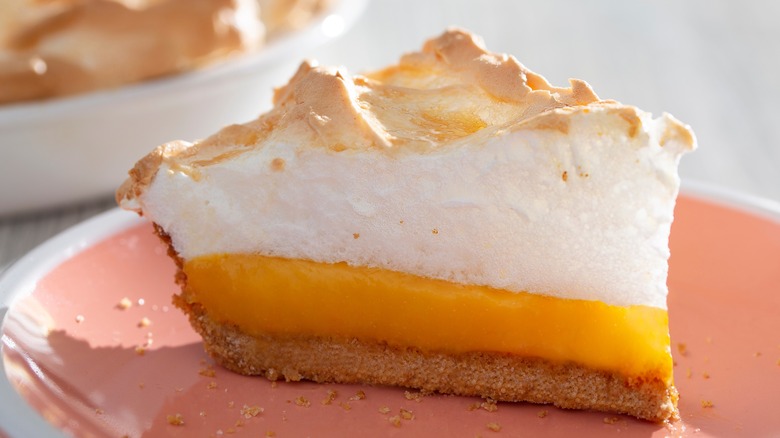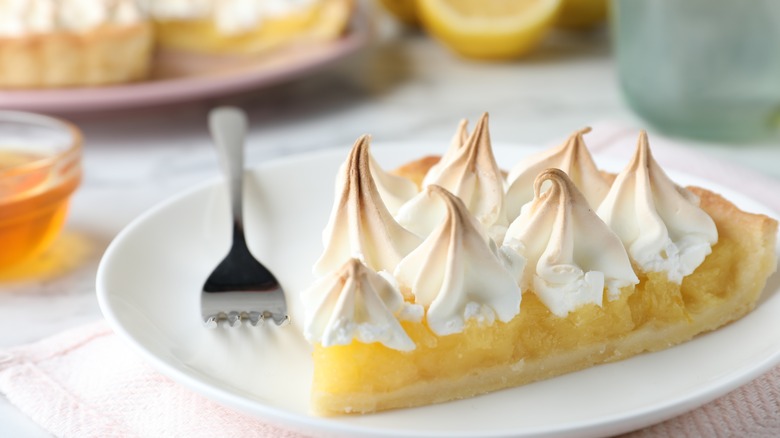The Most Infuriating Lemon Meringue Pie Mistakes And How To Fix Them, According To The Pros
Lemon meringue is a delicious type of pie to eat, that's for sure. But to make? It's a little less of an enjoyable experience.
The reason why lemon meringue pie is such a difficult recipe to make at home is simple. It requires perfecting three separate parts: the lemon custard base, the piped meringue, and the crust. Although creating stellar individual components is important, each of them also influences the others. Mess one up, and you could potentially risk an unappetizing slice of pie.
Luckily, we've done some of the legwork for you and found a couple of pie experts willing to share their insight into some of the most common mistakes people make with this challenging dessert, as well as how to avoid and fix them. They include Kristen Baileys, co-founder of Bake Eat Love, Cassidy Cabel, executive pastry chef at Union Patisserie, and Kaity Mitchell, pastry chef at the Unconventional Diner.
Forgetting to weigh your ingredients
Being an effective baker is all about being precise, and lemon meringue pie certainly leaves no room for error. Weighing all of your ingredients prior to preparing and baking your pie is key to ensuring that your flavors are balanced and that each ingredient can perform its structural function to the fullest extent possible. Kaity Mitchell, pastry chef at the Unconventional Diner, shares that properly measuring ingredients is an important step to undertake, especially when it comes to measuring eggs for custard. "The egg yolks are a huge part of what gives the filling its beautiful yellow color, and they are an important stabilization ingredient," she says. "Since they vary in weight from yolk to yolk, I always weigh my ingredients for consistency." The same can be said about the egg whites, which can also vary in size. Although the difference between large and extra-large eggs might seem minute, it could have a snowball effect on your entire recipe.
Precisely measuring your ingredients is also an important part of making your pie crust. If you add too much flour, you'll risk your crust coming out too crumbly. But too little flour, and it will be a greasy mess. To properly measure the flour for your crust, you'll want to pull out your kitchen scale instead of the cups — since these are notoriously inaccurate measurement tools.
Using the wrong type of meringue
Lemon meringue pie wouldn't be lemon meringue pie without, well, the meringue. But, not all types of meringue are created equal and are ideal for your recipe. Kaity Mitchell uses an Italian meringue for her lemon meringue pie recipe because she claims it's the "most stable" of the meringues. Besides the stability, she shares that this type of meringue also cuts well and has a sublime, creamy consistency, thanks to the addition of a hot sugar syrup. "It doesn't usually break down as quickly as a French meringue, American meringue, or even a Swiss meringue might. Because you cook the sugar before adding it to the whites, you also have less of a chance of an unpleasant granular texture," Mitchell says.
Kristen Baileys from Bake Eat Love shares that French meringue, while simple, is not the best fit for your recipe, either. She says that this type of meringue is prone to weeping more than other varieties, and also needs to be cooked before it can be added to a ready-to-eat pie.
Adding the sugar to the meringue all at once
The sugar in the meringue is what makes it a meringue, rather than just whipped egg whites. Kristen Baileys shares that the sugar not only stabilizes the egg whites, but it also encourages volume, a glossy texture, and color — should you decide to flambee it with a torch before serving it.
But, there are many hidden pitfalls associated with adding this granular ingredient to a smooth, silky egg white base. One of them is adding your sugar all at once, rather than in small increments. "When making a meringue I always suggest that you first whip the egg whites to its full volume then slowly add in the sugar while the mixer is still on medium high," says Cassidy Cabel from Union Patisserie. "This helps the meringue to develop a stronger protein structure and the sugar to dissolve evenly."
Kaity Mitchell shares that adding the sugar incrementally is even more important when it comes to making an Italian meringue. "If you add too much of the heated sugar at once, it raises the temperature of the eggs too quickly and can lead to your egg whites cooking — resulting in a lumpy meringue," she says.
Overwhipping the meringue
The perfect, towering meringue is soft and sweet — not lumpy and hard. If your egg whites are coming out of the stand mixer looking more like frosting, you could have made one of the biggest mistakes with your meringue: over-whipping the egg whites.
The key to preventing this major mistake is to know what to look for in a perfectly stiff-peaked meringue. "The perfect whipped meringue is glossy and holds a stiff peak of about 2 to 3 inches from the whisk; the very tip of the meringue may fold over just a bit but not completely curve into a 'C,'" says Cassidy Cabel.
Kristen Baileys shares that you should also be on the lookout for over-whipped meringue, which she notes will have "lost its glossy sheen" and instead has a "dry, grainy, or lumpy texture." Noticing this early on will allow you to stop your stand mixer, assess, and take steps to correct it. One easy way that you can fix overbeaten egg whites is to add a little bit of fresh whites to the mixture; just make sure you don't over-whip those, too.
Not cooking your filling enough
A key component of your lemon meringue pie is the lemon custard filling. It's a little thinner than lemon curd, though the pie filling often gets confused with this other citrusy spread.
The pie filling needs to be properly cooked down and set so that it forms a gelatinous, pudding-like texture inside of your pie shell. And one of the mistakes that people make with the pie is not cooking the filling itself enough. "If the curd is too thin when added to the crust, it's unlikely to set," says Kristen Baileys. And when it doesn't set, you get a snowball of issues — from a sinking meringue to a soggy crust.
You'll want to cook your pie filling on the stove until it starts to resemble pudding, per Kristen Baileys. She recommends cooking this pie filling to about 170 degrees Fahrenheit before removing it from the heat and cooling it completely.
Not whisking your yolks enough when they're cooking
One of the most common mistakes that people encounter with lemon meringue pie is that dreaded lumpy filling. One of the likely culprits? Not whisking your egg yolks enough when they're sitting on the double boiler or in your pan.
The egg yolks need to move around constantly so that they can mix with the sugar. Keeping one hand on the whisk, per Cassidy Cabel's advice, will ensure that your lemon filling is well-mixed rather than lumpy. You'll also need to actively continue whisking your mixture after you add your lemon juice and extra sugar. This will form the basis for a smooth, creamy custard.
To avoid scrambling (egg pun intended) around your kitchen, be sure to crack the eggs that you need for your filling ahead of time and add them to a bowl. This will ensure you can direct your focus, and hands, to stirring the mixture and getting the most even heat distribution possible.
Forgetting the stabilizers in your filling and meringue
It's totally understandable that you would want to avoid using "shortcuts" to make your lemon meringue pie. But if the pros do it? Well, then there might be some merit in trying them out for yourself.
One of the ingredients that our experts swear by for a good lemon meringue pie filling is cornstarch. It's important to note that if you add this thickener to your pie filling, it has to cook to at least 140 degrees Fahrenheit, per Cassidy Cabel, in order to properly thicken. Though, as our other experts note, you'll need the entire filling to reach between 170 to 180 degrees Fahrenheit to be fully cooked. So, if you're using cornstarch and finding out that your pie filling isn't thick enough, you may have simply not given it enough time to work its magic.
Another ingredient that can be a lifesaver, specifically for the meringue, is cream of tartar. You can add in a little bit of this ingredient when your meringue reaches the soft peak stage. It will help stabilize it and make it easier to work with.
Not getting creative with your crust
If you take a scroll through the tons of lemon meringue pie recipes on the internet, chances are that you'll find an array of different types of pie crust being suggested. The first, and most obvious, is the classic pie pastry, made with flour, fat (often butter, but sometimes shortening or coconut oil), salt, and water. It's a classic, and it will lend you a sturdy crust that will support the weight of your dense layers. Another benefit you'll find, per Kaity Mitchell, is a sublime flavor balance. "Lemon meringue pie can and should be nice and tart, so having the buttery pie crust layer helps to balance that out," she says.
But, you can also experiment with other pie crusts to add an extra boost of flavor to your recipe. Try a simple graham cracker crust to add an extra dose of sweetness to your recipe, or find a complementary cookie flavor to try a crumb crust with. For example, crumbled crunchy gingersnaps could provide a warming contrast to the sharp lemon filling. Or, you may consider adding herbs and spices to your pie crust, like dried thyme or rosemary, for a more sophisticated flavor pairing.
Forgetting to blind-bake your crust
Regardless of the type of crust that you select for your recipe, you will likely need to blind-bake it before you can add your filling. Blind-baking is an important step for this type of pie, because the filling is already cooked, and the meringue is just added on top (and torched, if desired). The whole dessert doesn't need to be put back in the oven after it's assembled. So, you have to allocate some time for your pie crust to cook.
In order to blind-bake your flaky pie crust correctly, you'll want to assemble it in the tin and gently prick the bottom with a fork. This will prevent the steam from rising upwards and giving your crust too much puff. Then, add a piece of parchment and pack on the ceramic pie weights or dried beans to weigh your crust down. Since you're not putting the pie back into the oven, you can bake the crust until it's golden brown and firm to the touch — but not to the point where it's super dry. You'll also likely need to bake your homemade graham cracker crust as well (if you opt for it instead of the classic crust) to help it firm up and set.
Regardless of the crust type you select, always be sure to cool down the pie crust before adding in your layers. This will prevent some of the textural issues that may result with a warm crust and a comparatively colder filling.
Letting your curd cool too much before adding the meringue
Meringue is a very, very finicky thing. And, it's very, very temperature sensitive. If you place your pie filling into the fridge, or the freezer, and pipe your meringue onto it, you'll risk one of the most dreaded effects of meringue pie baking: weeping.
Weeping is just the condensation that forms during a rapid temperature change. If you pipe your meringue onto a cold pie, it will sit on top, rather than fully stick and form against top of the pie. Kaity Mitchell recommends piping meringue onto the pie when both are room temperature to reduce the risk of weeping.
Another strategy to mitigate how much your meringue weeps is to spread the meringue to the edges of the crust, rather than piping it onto just the curd. This will help trap the moist lemon custard underneath and give the meringue something to bind to. You should also be sure to mix your meringue well to avoid any residual sugar granules, which have been known to exacerbate condensation.
Not cooling your pie enough before slicing it
Again with the temperatures? By this point in the process, you're probably groaning over seeing another temperature-specific tip. But this one is really, really important because otherwise, you could be left with a pie that gets rather messy when you go to slice into it with a knife.
Cassidy Cabel recommends allocating some time for your lemon meringue pie to fully cool before it's time to slice it. She suggests leaving it on the counter for two hours before transferring it to your fridge for another four. Meanwhile, Kaity Mitchell goes so far as to suggest that letting your pie set in the fridge overnight can make for a clean-cut slice. While the semantics might differ based on who you ask, the general consensus is that you shouldn't slice into your pie immediately after you assemble it.
Luckily, Kristen Baileys has some advice for how to tell when your pie is prime for the slicing. "Once the filling is set and doesn't jiggle when the pie is gently shaken ... it's ready to slice. The wait will be worth it for a clean slice," she says. Despite our hunger pains, we'll trust her on this one.
Waiting too long to eat your pie
Everyone knows the feeling. You make a pie, it comes out with a crispy, well-baked bottom and everything. Then you come back to your pie the next day and notice that the crust is limp, soggy, and sad.
Lemon meringue pie is just one dessert that's best on the day you made it, rather than several days later. After all, placing your pie in the fridge not only causes the crust to get soggy, but it can also cause the meringue to weep, per Cassidy Cabel.
Unfortunately, there is no way around refrigerating your pie, since it contains perishable ingredients like eggs. You can help the texture on day two, though, by leaving your pie uncovered in the fridge and ensuring that it goes in to the refrigerator fully-cooled. Or, just encourage everyone to take at least two slices; with these tips, your pie is bound to be so good that no one will think twice about it.
